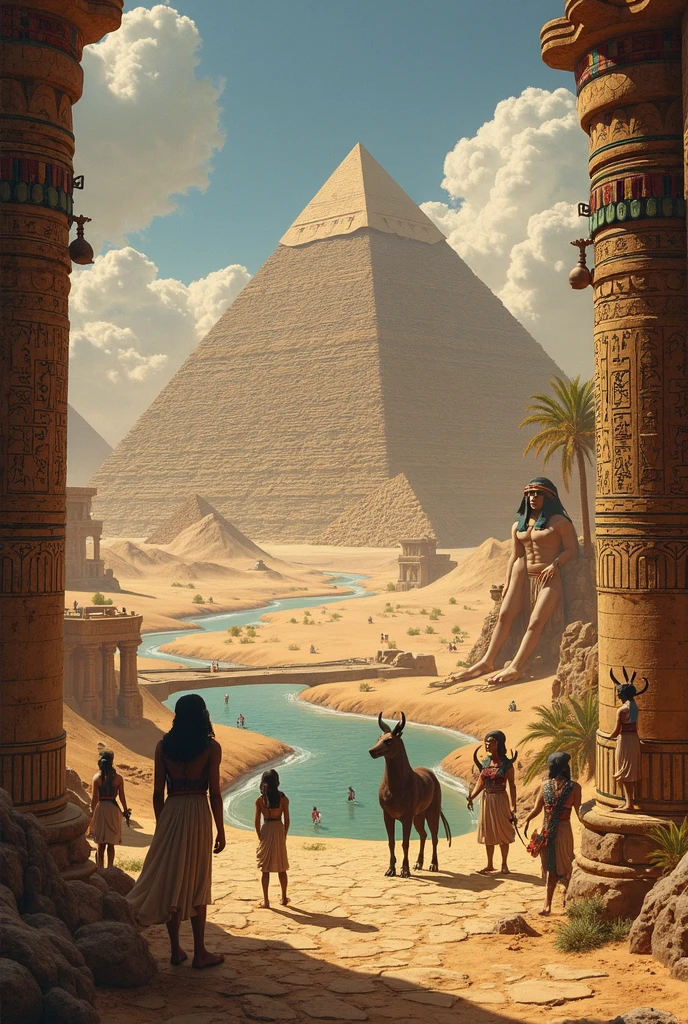Yoruba Mythology: The World of Orishas and Divine Forces
The Yoruba mythology is one of the richest spiritual traditions in West Africa, deeply rooted in the beliefs of the Yoruba people of Nigeria, Benin, and Togo. At its core are the Orishas, powerful deities who govern natural forces, human destiny, and moral order. These divine beings, such as Shangó, Yemaya, and Olorún, play a central role in rituals, divination systems like Ifá, and syncretic religions such as Santería.
The Origins of Yoruba Cosmology
According to Yoruba tradition, the universe was created by Olorún (also known as Olodumare), the supreme god who reigns over the heavens. Unlike other Orishas, Olorún is distant from human affairs, delegating responsibilities to lesser deities. The Yoruba pantheon consists of hundreds of Orishas, each associated with specific aspects of life, nature, and human endeavors.
Key Concepts in Yoruba Beliefs
- Ase (Ashé): The divine energy that empowers all beings and rituals.
- Orí: The personal destiny or spiritual head chosen before birth.
- Egungun: Ancestral spirits honored in ceremonies.
The Most Revered Orishas
Below is a table highlighting the primary Orishas, their domains, and their symbols:
| Orisha | Domain | Symbols |
|---|---|---|
| Olorún | Supreme creator, sky | Sun, white cloth |
| Shangó | Thunder, fire, justice | Double axe, red and white colors |
| Yemaya | Ocean, motherhood | Blue dress, seashells |
| Ogun | War, iron, technology | Machete, black and green colors |
| Oshun | Love, rivers, fertility | Honey, gold, mirrors |
The Role of Ifá and Divination
The Ifá system is the spiritual backbone of Yoruba religion, used to communicate with the Orishas. Priests called Babalawos interpret messages through sacred palm nuts or a divination chain (Opele). Each of the 256 Odus (divinatory signs) contains proverbs, stories, and guidance for life’s challenges.
Santería: The Diaspora Adaptation
During the transatlantic slave trade, Yoruba beliefs merged with Catholicism in Cuba, giving rise to Santería (Lucumí). This syncretic religion preserved the worship of Orishas under the guise of Catholic saints. For example:
- Shangó became associated with Saint Barbara.
- Yemaya was syncretized with the Virgin of Regla.
Rituals and Offerings to the Orishas
Devotees honor the Orishas through ceremonies involving dance, drumming, and offerings (ebó). Each deity has preferred foods, colors, and sacrificial items. For instance:
- Shangó receives ram’s blood and spicy foods.
- Yemaya is offered watermelon and molasses.
For deeper insights into Yoruba traditions, explore these resources: Encyclopedia Britannica on Orishas, The Met’s Yoruba Art Collection, Smithsonian’s Ifá Divination Guide.
Descubre más artículos sobre mitología y espiritualidad en nuestra web y únete a nuestra comunidad en facebook.com/zatiandrops.
Certain cities hold immense spiritual significance in Yoruba mythology, serving as epicenters of worship and pilgrimage. Ile-Ife, regarded as the birthplace of humanity, is where Oduduwa, the progenitor of the Yoruba people, descended from the heavens. Another key site is Oyo, historically linked to Shangó, where annual festivals still celebrate his fiery legacy. These cities are not just geographical locations but living embodiments of divine energy (Ase).
The Creation Myth: Oduduwa and Obatala
While Olorún is the supreme creator, the task of shaping the Earth fell to Obatala, the god of purity and wisdom. According to legend, Obatala descended with a chain from the heavens, carrying a snail shell filled with sacred soil and a five-toed chicken to spread it. However, his brother Oduduwa completed the task when Obatala became intoxicated by palm wine. This duality reflects the Yoruba belief in balance and shared responsibility among the Orishas.
Symbolism in Yoruba Creation Stories
- Snail Shell: Represents the cyclical nature of life and time.
- Five-Toed Chicken: Symbolizes the scattering of chaos to form order.
- Palm Wine: A reminder of both creativity and fallibility.
The Concept of Reincarnation (Atunwa)
Unlike Western notions of reincarnation, the Yoruba belief in Atunwa emphasizes the return of ancestral spirits within the same family lineage. A child believed to be the reincarnation of a grandparent might inherit their name (oríkì) and traits. Diviners (Babalawos) often identify these connections through Ifá readings, ensuring the child aligns with their predestined path (Orí).
| Ancestral Role | Modern Manifestation | Ritual Significance |
|---|---|---|
| Warrior (Ogun) | Child with fearless demeanor | Iron bracelet for protection |
| Healer (Osanyin) | Child drawn to herbs | Leaf-infused baptismal water |
| Leader (Oduduwa) | Child born with a caul | White cloth initiation |
The Egungun Masquerade: Honoring Ancestors
The Egungun festival is a vibrant spectacle where masked dancers embody ancestral spirits. These elaborately costumed figures, draped in multilayered cloth, deliver blessings and warnings to the community. The masquerade serves as a bridge between the living and the dead, reinforcing the Yoruba tenet that ancestors remain active guides. Each movement and color in the performance holds coded meanings, decipherable only by initiates.
Materials Used in Egungun Costumes
- Aso-Oke: Handwoven fabric symbolizing status.
- Cowrie Shells: Represent wealth and divine favor.
- Indigo Dye: Linked to spiritual depth and mystery.
The Orishas in Nature: Sacred Groves and Rivers
Natural landmarks are often consecrated to specific Orishas. The Osun-Osogbo Sacred Grove, a UNESCO World Heritage Site, is dedicated to Oshun, with its river believed to heal infertility. Similarly, the Ogun River is a site for metalworkers’ rituals, honoring Ogun’s mastery over iron. These spaces are not merely symbolic but are treated as living sanctuaries where the Orishas physically manifest.
The Diaspora’s Influence: Candomblé and Vodou
Beyond Santería, Yoruba spirituality permeated Brazil’s Candomblé and Haiti’s Vodou. In Candomblé, Yemaya is worshipped as Iemanjá, celebrated lavishly on New Year’s Eve with ocean offerings. Vodou adapted Ogun as Ogou, a warrior-loa syncretized with Saint James. These adaptations highlight the resilience of Yoruba cosmology under oppression.
Comparative Orisha Names Across Diaspora Religions
| Yoruba Name | Santería (Lucumí) | Candomblé (Brazil) | Vodou (Haiti) |
|---|---|---|---|
| Oshun | Our Lady of Charity | Oxum | Erzulie Freda |
| Elegua | Saint Anthony | Exu | Papa Legba |
| Oya | Saint Teresa | Iansã | Maman Brigitte |
The Art of Yoruba Mythology: Sculptures and Beadwork
Yoruba artistry is a devotional act, with sculptures and beadwork encoding sacred knowledge. Ibeji statues, carved to honor deceased twins, are ritually washed and fed to appease their spirits. Crowns (Ade) adorned with bead veils conceal kings’ faces, reflecting the belief that rulers embody Orishas on Earth. The intricate patterns in these artworks often map to Ifá verses, making them three-dimensional prayers.
For further exploration, visit: World History Encyclopedia on Yoruba Religion, National Museum of African Art’s Yoruba Collection, Sacred Texts’ Yoruba Folklore Archive.
Descubre más artículos sobre mitología y espiritualidad en nuestra web y únete a nuestra comunidad en facebook.com/zatiandrops.
The Concept of Ori: Personal Destiny and Spiritual Identity
In Yoruba mythology, the concept of Orí (spiritual head) is fundamental to understanding human existence. Before birth, each individual chooses their destiny in the presence of Olorún, which is sealed within their Orí. Unlike Western ideas of fate, Orí is dynamic—it can be nurtured or neglected through one’s actions. Devotees often perform rituals to strengthen their connection to their Orí, such as offering kola nuts or reciting personal praise poems (oríkì).
Components of Orí
- Orí Inu (Inner Head): The spiritual essence guiding one’s destiny.
- Orí Ode (Outer Head): The physical head, representing worldly identity.
- Ayanmo: The chosen path, which can be revealed through Ifá divination.
The Role of Women in Yoruba Spirituality
Women hold pivotal roles as priestesses (Iyalorishas) and diviners in Yoruba traditions. Deities like Oshun and Yemaya exemplify feminine power, governing love, fertility, and protection. The Gelede festival, dedicated to maternal ancestors, showcases masked dances that honor women’s societal and spiritual contributions. This matriarchal undercurrent contrasts with many global mythologies that prioritize male deities.
| Female Orisha | Domain | Cultural Impact |
|---|---|---|
| Oshun | Rivers, sensuality | Patron of artists and healers |
| Oya | Storms, transformation | Symbol of menopausal wisdom |
| Nana Buluku | Creation, primordial waters | Venerated as the “Grandmother” deity |
The Warrior Orishas: Ogun and Elegua
While Ogun governs war and metallurgy, his ally Elegua (also spelled Eshu) controls crossroads and opportunities. Together, they embody the duality of conflict and resolution. Offerings to Ogun include iron tools and palm oil, while Elegua prefers candies and rum—a reminder that even trickster deities demand respect. Their myths warn against arrogance, as both punish injustice with swift retribution.
Modern Manifestations of Warrior Orishas
- Ogun: Invoked by surgeons and engineers for precision.
- Elegua: Petitioned before business ventures or travel.
Yoruba Music and Dance as Sacred Language
Drums like the Bata are considered vessels for Orishas to speak. Each rhythm corresponds to a deity—for example, the Iyá drum calls Yemaya, while the Gbedu invokes Ogun. Dancers enter trance states (orisha possession), becoming conduits for divine messages. This synergy of sound and movement is called Ayan, a sacred art form preserved through guilds.
The Ethical Framework: Iwa Pele
Iwa Pele (gentle character) is the moral cornerstone of Yoruba spirituality. It emphasizes humility, honesty, and community harmony—qualities reflected in proverbs like “The head that wears a crown does not itch”. Violations, such as theft or betrayal, are believed to disrupt one’s Ase and invite Orishas’ wrath. Restorative justice often involves rituals to cleanse the offender’s Orí.
Principles of Iwa Pele
- Otito (Truth): Honesty in speech and action.
- Ifarabale (Patience): Endurance through life’s trials.
- Oore (Kindness): Generosity without expectation.
Yoruba Influence on Modern Culture
From Beyoncé’s homage to Oshun in Lemonade to the global popularity of Afrobeat music, Yoruba motifs permeate contemporary art. The Adinkra symbols of Ghana and the Vodou flags of Haiti both trace lineage to Yoruba iconography. Even modern psychology draws parallels between Orishas and Jungian archetypes.
| Modern Medium | Yoruba Influence | Example |
|---|---|---|
| Literature | Wole Soyinka’s plays | Death and the King’s Horseman |
| Fashion | Adire (indigo-dyed cloth) | Designers like Duro Olowu |
| Film | Nollywood mythology plots | Òlòturé (2019) |
Controversies and Misconceptions
Western depictions often reduce Orishas to “pagan idols,” ignoring their philosophical depth. Similarly, animal sacrifices—integral to ebó rituals—are misrepresented as cruelty rather than sacred reciprocity. Scholars like Wande Abimbola argue that Yoruba spirituality is a sophisticated ethical system, not mere superstition.
For further study, explore: Library of Congress Yoruba Archives, BBC’s Yoruba Deities Feature, Academic Journal on Ifá Divination.
Descubre más artículos sobre mitología y espiritualidad en nuestra web y únete a nuestra comunidad en facebook.com/zatiandrops.
The Sacred Calendar: Festivals and Lunar Cycles
Time in Yoruba mythology is measured through a lunar calendar intertwined with agricultural and spiritual cycles. Key festivals like the Odun Egungun (Ancestors’ Festival) and Odun Olojo (Celebration of the First Dawn) align with specific moon phases. These events are not mere traditions but active renewals of cosmic contracts between humans, Orishas, and ancestors.
Major Yoruba Festivals
| Festival | Honored Deity | Significance |
|---|---|---|
| Odun Ifá | Orunmila (Wisdom) | Divination priests receive new insights |
| Osun-Osogbo | Oshun | Purification of the sacred river |
| Oro | Ogun & Elegua | Community justice rituals |
The Science of Herbs: Osanyin’s Legacy
The Orisha Osanyin, master of herbal medicine, governs a vast pharmacopeia of over 1,000 sacred plants. Yoruba herbalists (Onisegun) use these for healing, spiritual protection, and ebó rituals. Plants like ewe asunwon (bitter leaf) and akoko (Newbouldia laevis) are believed to channel Ase. Modern research now validates many traditional uses, such as Morinda lucida’s antimalarial properties.
Sacred Plants and Their Uses
- Ewe Aje (Money Plant): Attracts prosperity when placed in markets.
- Atare (Alligator Pepper): Used in oath-taking ceremonies.
- Orogbo (Bitter Kola): Offered to Orunmila for wisdom.
The Architecture of Worship: Shrines and Temples
Yoruba sacred spaces are designed as microcosms of the universe. A typical Orisa shrine contains:
- Opele (Divination Chain): Hung at the entrance for consultations.
- Opon Ifá: Carved wooden tray holding divination powder (iyerosun).
- Igba Orisha: Ceramic vessels housing deity energies.
The Oba’s Palace in Ile-Ife features 201 sacred pots symbolizing the Orishas, demonstrating how governance and spirituality intertwine.
Yoruba Astrology: The Ifá Star System
Beyond terrestrial divination, Ifá incorporates celestial knowledge. The Irosun Meji constellation (Orion’s Belt) guides agricultural timing, while the Odu Ogbeate star cluster warns of societal upheavals. Each of the 16 major Odu correlates with planetary alignments, creating a sophisticated astrological framework predating Western systems.
| Odu | Celestial Body | Human Influence |
|---|---|---|
| Oyeku Meji | Moon | Dreams & intuition |
| Iwori Meji | Venus | Relationships & arts |
| Odi Meji | Mars | Conflict resolution |
The Taboos: Awo and Forbidden Acts
Certain prohibitions (Eewo) maintain spiritual balance. For example:
- Eating pork is forbidden for devotees of Shangó.
- Whistling at night may attract Ajogun (negative forces).
- Breaking kolanuts improperly insults Orunmila.
Violating Eewo requires cleansing rituals to restore Ase.
The Language of Colors in Yoruba Rituals
Colors are vibrational languages to the Orishas. A 2020 study at the University of Ibadan documented how specific hues induce trance states during ceremonies:
- White (Obatala): Purity, worn during initiations.
- Red/White (Shangó): Dual energies of fire and justice.
- Indigo (Yemaya): Depth of oceanic wisdom.
Yoruba Mythology in Global Linguistics
Over 300 Yoruba words entered the diaspora lexicon, including:
| Yoruba Term | Global Adaptation | Meaning |
|---|---|---|
| Àse | “Axe” (Brazilian Portuguese) | Divine affirmation |
| Ogun | “Hoodoo” (African-American) | Protective magic |
| Egúngún | “Gun” (Caribbean slang) | Ancestral respect |
For deeper dives, consult: Pew Research on Diaspora Religions, Yoruba Ethnobotany Studies, Rock Art Evidence of Yoruba Cosmology.
Descubre más artículos sobre mitología y espiritualidad en nuestra web y únete a nuestra comunidad en facebook.com/zatiandrops.


